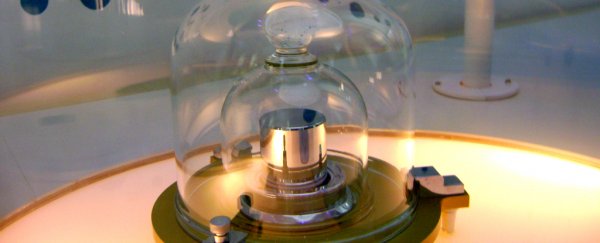After decades of debate and extensive testing, an international team of scientists might finally be about to agree on the exact mass of a kilogram.
You might think the mass of a kilogram is already pretty obvious - it's 1,000 grams, or 2.2 pounds, right? But it's more complicated than that, because right now, the mass of a kilogram is defined by a single physical object - a solid hunk of metal sitting in a vault in France known as the International Prototype Kilogram (IPK), or 'Le Grand K'.
There are a bunch of other copies of this cylinder around the world, but a kilogram essentially is only defined by whatever the IPK weighs. And it's the only International System (SI) unit that's still defined by a physical object.
That sounds pretty crazy - and from a scientific point of view, it is. Despite how well-guarded the IPK is, it's still subject to lose and gain atoms over time - and indeed, the cylinder seems to have become slightly heavier over the years as a result of surface contamination.
Since a lot of our scientific assumptions are based on the mass of a kilo – along with the other six SI units - remaining constant, this is a big problem. Not to mention the fact that everyone on the planet should be able to find out the exact mass of a kilo, not just those with access to the IPK.
That's why scientists have been trying for the past two decades to establish a set mass of a kilogram, independent of the IPK.
But it hasn't been as easy as you might imagine. Even though experiments that could set the mass of the kilo were outlined in the 1970s, it's only this past year that two different methods have been able to achieve results that are similar enough to replace Le Grand K. And this week a meeting was held to discuss the future of the kilogram.
Basically, to define a kilo without the IPK, scientists need to know Planck's constant, which relates a particle's energy to its frequency - but is surprisingly hard to measure.
One team - led by Joachim Ullrich, president of the German National Metrology Institute - managed to do this by building two perfect silicon spheres that each weigh the same as a kilogram, and then counting every single atom in them.
Another team used a device called a watt balance, which aims to get a value for Planck's constant by weighing a test object against an electromagnetic force.
Suffice it to say, all of this has taken a lot of researchers a lot of time. But late last year, Nature reports that the two teams reached an agreement, and managed to independently define Planck's constant within 12 parts per billion of each other. Those values have now been published, just in time for a broader redefinition of the SI units that's scheduled for 2018.
However, it's not all set in stone just yet. The teams now have until 1 July 2017 to publish further data before the value of Planck's constant is fixed.
Ullrich's team is now planning a more precise experiment before then, and if the values for Planck's constant come out very differently, it'll throw a big spanner in the works.
But Richard Davis, former head of the mass division of the International Bureau of Weights and Measures, which houses the IPK in Sèvres, France, is confident that won't happen.
"This train has a lot of momentum and there has to be something seriously wrong to derail it," he told Elizabeth Gibney over at Nature.
So it seems that Le Grande K might finally get its long-sought-after retirement. And just in case you were wondering what it'll do next, don't worry, it'll be safely stored in a museum.
"We'll keep it," says Davis, "but it won't be defining anything anymore."
